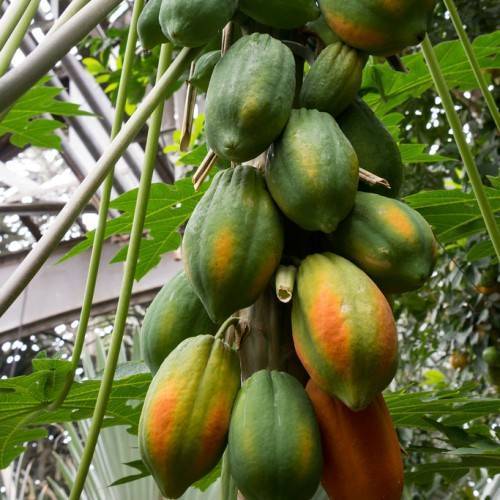
papaya
Carica papaya 'T. R. Hovey'
Cycle:
Perennial
Watering:
Average
Hardiness Zone:
10 - 12
Flowers:
Flowers
Sun:
Full sun
Fruits:
Fruits Ready In Summer
Edible:
Yes
Leaf:
Yes
Growth Rate:
High
Maintenance:
Moderate
Salt Tolerant:
Yes
Care Level:
Medium
watering
Papaya (Carica papaya 'T. R. Hovey') should be watered at least twice a week. To ensure that the plant gets enough moisture, give it a thorough watering whenever the top 1-2 inches of the soil is dry to the touch. During hot and dry weather, you may want to water it more frequently. Additionally, make sure to water the soil evenly, providing enough water to wet the entire root ball. This will help promote a more even growth and keep your papaya from becoming imbalanced or lopsided.
sunlight
Papaya (Carica papaya 'T. R. Hovey') needs at least 8 hours of direct sunlight per day to grow and thrive. Most papaya varieties prefer full sun exposure year round to achieve optimal growth and production. Once established, this plant species should be placed in a location or area of the garden that receives at least 8 hours of direct sunlight each day. This species should be watered during dry and hot periods, when rainfall is inadequate, and only when needed after the should surface of the soil has dried to the touch. Papaya plants benefit from regular fertilization with a balanced fertilizer and should be pruned as necessary.
pruning
Papaya (Carica papaya 'T. R. Hovey') should be pruned annually to maintain its overall health and shape. Pruning should take place during the winter months when the plant is dormant to reduce damage to the growing tips. Begin by removing any dead, diseased, or injured branches. Then, remove any branches that hinder the plant’s natural shape. You can also thin out overcrowded branches or reduce a branch’s length to promote better air circulation. Lastly, remove any suckers or fruit stalks that emerge from the base of the plant, as these can hinder growth. Always use sharp, clean pruning tools to avoid damage or disease transmission. If you need additional information or assistance with your papaya plant, consult a local gardening expert.
Season
Hardiness Map
FAQ
Can papaya trees bear fruit in the tropics?
Yes - papaya trees can bear fruit in the tropics. They are native to the tropics and are extremely adaptable to the warm and humid climates that are common there. Papaya trees will typically produce a generous harvest of bright orange or yellow-skinned papayas with sweet, juicy flesh inside. The trees need plenty of light, humidity, and warm temperatures to grow and will bear fruit sooner in the tropics than in other climates.
Does papaya fruit grow all year round?
No, papaya fruit does not grow all year round. Papaya fruit's growing season is typically from March through October in the United States, although its peak season is from June to August. In other parts of the world, such as Hawaii and some parts of Asia and Central America, the growing season may last longer and vary in length based on climate.
Can papaya trees be self-pollinated?
Yes, papaya trees can be self-pollinated. Self-pollination most commonly occurs in papaya when the male flower is mature and the female flower is still in the bud stage, prior to opening. This occurs when the pistils of the female flower become receptive before the stamens of the male flower become viable, allowing the male flower to self-pollinate itself. However, if the male flower does not self-pollinate, cross-pollination by insects may be needed to occur.
Are there any best times to plant papaya seeds?
There is no definitive 'best time' to plant papaya seeds as they can be planted all year round. In tropical climates, papaya seeds can be planted year-round in warm soil; however, those in cooler climates may wish to wait until late spring to early summer to plant outside. Either way, it is important to ensure that the soil is warm before planting and that the climate conditions are suited to the plant's growth requirements. Additionally, papaya plants need to be watered regularly to ensure proper growth.
